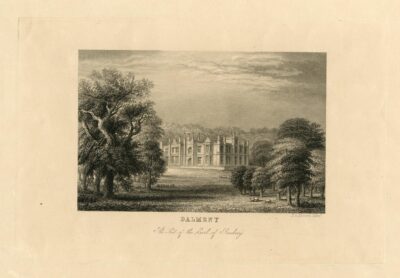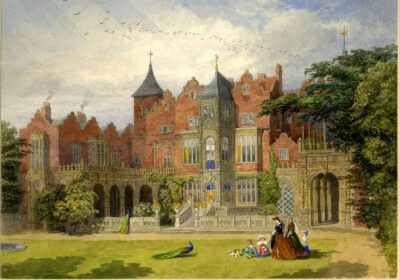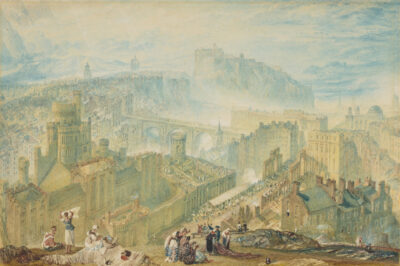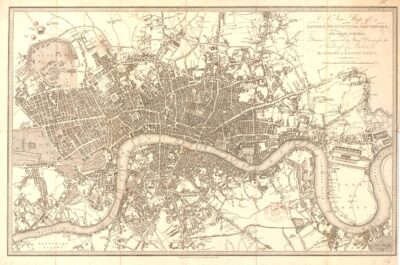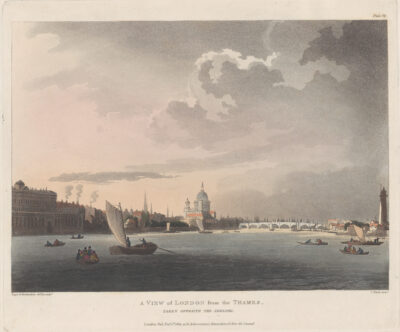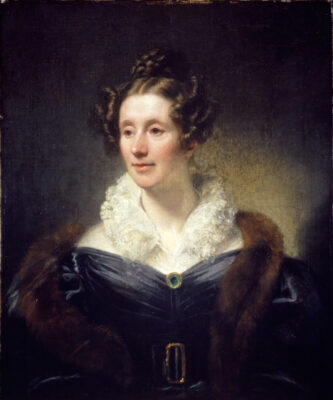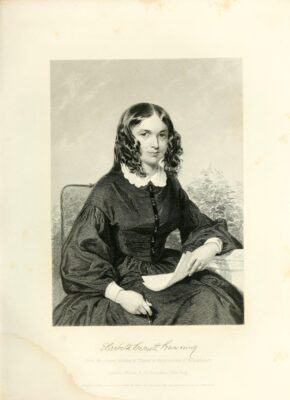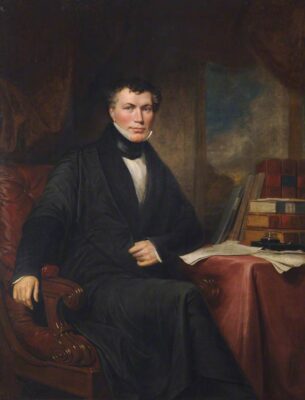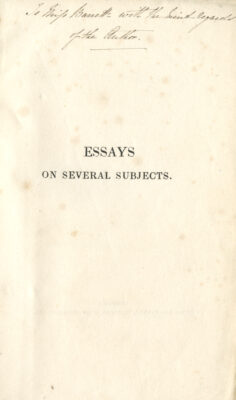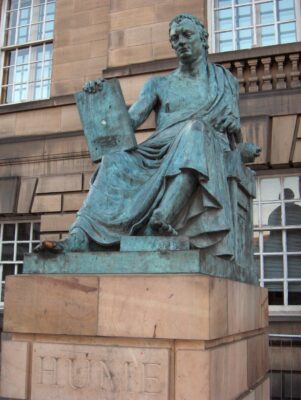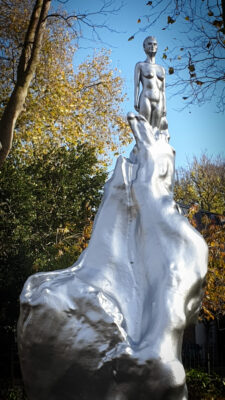Lady Mary Shepherd
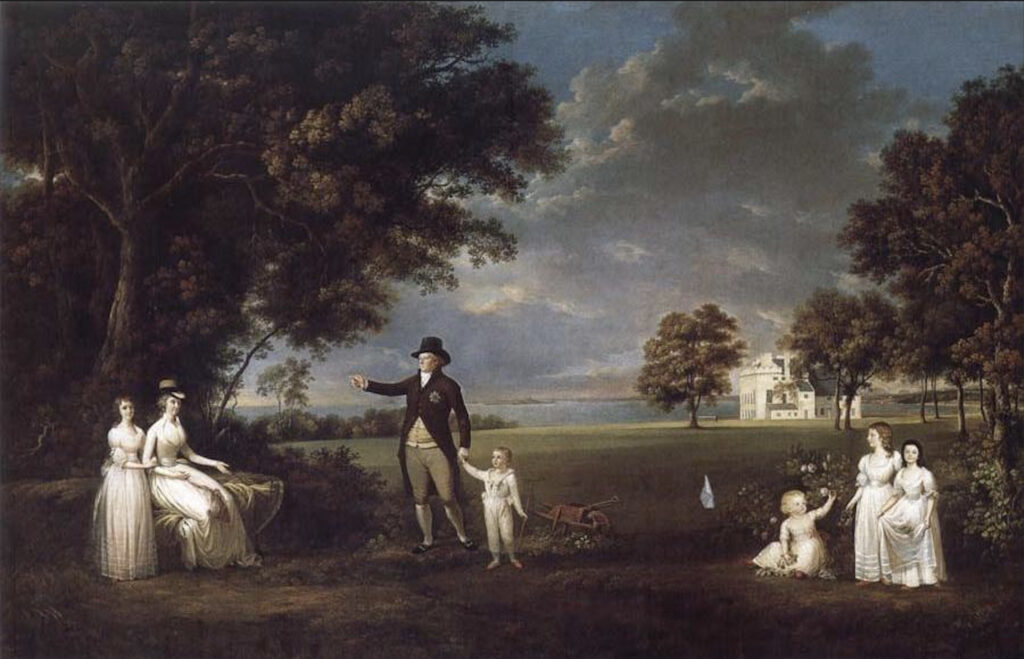
“…the mind strives, if possible, to find the very essences of things from the bare comparison of the relations of its ideas: for, although we be philosophers enough to know it is impossible to do so, we are for ever endeavoring to catch at, and yet for ever disappointed at not meeting with, those essences.” —Lady Mary Shepherd, in Fraser’s Magazine for Town and Country (1832, 708).
Mary Shepherd (1777–1847) was a Scottish philosopher who engaged with numerous scientific and philosophical issues of her era within an especially rich intellectual context. Dividing her time between Edinburgh and London, her intellectual network involved an impressive list of leading philosophical, literary and scientific figures, including the scientist Charles Babbage, the philosophers Mary Somerville and William Whewell, the economist David Ricardo, and the writers Mary Shelley and Samuel Taylor Coleridge. In her two major publications, Essay Upon the Relation of Cause and Effect (1824) and Essays on the Perception of An External Universe (1827), along with various other articles, she tackles a wide range of late modern philosophical issues. She writes on causal relations, perception, the nature of time, the mind-body relation, the philosophical import of dreaming, and much else besides. In her two principal books, she also presents deep and insightful criticisms of David Hume’s understanding of causation and of George Berkeley’s idealism about the material world. In the first half of the 19th century, her work received considerable recognition in British intellectual life. Despite these historical facts, her work was later excised from dominant narratives of the development of philosophy in late modern Europe.
| Preferred citation and a full list of contributors to this entry can be found on the Citation & Credits page. |
1. Biography
The entry on Lady Mary Shepherd in Encyclopedia of Women in Philosophy admits that “not much is known about this thinker,” highlighting the need to better understand her life and contributions to philosophy. Mary (née Primrose) Shepherd was born near Edinburgh along the Firth of Forth in her family’s ancestral seat of Barnbougle Castle in Dalmeny parish. She was the second of five children to Neil Primrose, 3rd Earl of Rosebery, and Mary Vincent. Her eldest brother, Archibald Primrose, later became a Member of Parliament and 4th Earl of Rosebery. He was the grandfather of Archibald Rosebery, 5th Earl of Rosebery, and Prime Minister of the UK from 1894–1895.
Shepherd’s childhood was typical for a daughter of wealthy and aristocratic Scottish families of the period. The Primroses split their time between their estate in Dalmeny and London; Shepherd continued to live in Dalmeny with her family until she married at the age of 30.
In London, Shepherd’s family rented Holland House. According to Kensington Society, tragedies endured by the Holland family in 1774 led to the house being let to various “tenants including the third Earl of Rosebery” (Brandreth 1886, p. 27), Mary Shepherd’s father. A well-known salon run by the Fox family was held there; the house was a center of early 18th century political discussions among the Whigs.
Shepherd did not attend school but was instead tutored at home, in contrast to her brothers, who attended the local Dalmeny school and Cambridge University thereafter. This is not to say that girls were barred from formal instruction. In fact, the opposite is true: the Parish of Dalmeny school log lists 27 boys and 17 girls in attendance in 1792.
The Primroses’ economic and social standing allowed Lady Mary to study under a private tutor — Mr. Pillans — which offered a more prestigious and personalized education than the school in Dalmeny Parish. This personalized education pushed Mary to take an early interest in philosophy. In her memoir, Mary Shepherd’s daughter, Mary Elizabeth Shepherd Brandreth, confirms that “Mr. Pillans taught the girls Latin for the basis of language, Geography, Mathematics, History, and besides, a vast deal of thinking upon the elements of Truth as to things in general” (Brandreth 1886, p. 26). Each pupil “‘took up’ the portion which fell in with her own mind’s natural working” (Brandreth 1886, p. 26). The Brandreth memoir, Some Family and Friendly Recollections of 70 Years, is the only surviving document that provides this level of detail about Mary Shepherd’s life.
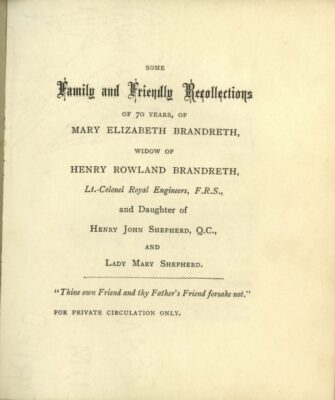
In a letter to Charles Babbage, Mary Shepherd herself explains how her intellectual formation encouraged her philosophical predilections:
“I can truly say that from a very early age, I have examined my thought, as to its manner of reasoning in numbers; and from time to time have applied such notices to other reasonings, either for amusement or improvement; — indeed chiefly in order to chastise the vague, illusory, illogical method of reasoning admitted with every part of discourse, whether gay, or serious, & into each department of literature however important its object.”
In addition to a rich and varied education, the Primrose children also had access to a large library. Jennifer McRobert writes that the family’s library listed 1000 volumes in its 1820 catalog (McRobert 2002, p. 28). According to her daughter, Mary Shepherd took advantage of this library; on a carriage trip to London with her father, Shepherd “…once took out of one pocket a volume of Milton, and out of the other Pope’s translation of the Odyssey. After a time he took hold of her chin and, while turning her head, said in a kind of melting voice, ‘Child, thee needn’t keep at books whilst we’re traveling — does your mother put such strict orders on you?” (Brandreth 1886, p. 33).
These anecdotes confirm that Shepherd showed great gusto for learning in her childhood, foreshadowing her later renown as a philosopher. Shepherd’s early interest in philosophy was also likely cultivated by the intellectual climate in Edinburgh during her early life.
In 1805, the Edinburgh intelligentsia became embroiled in a philosophical and legal debate now known as the “Leslie affair.” The issue involved in the debate, and on which Mary Shepherd’s philosophical treatises are based, was the relationship between cause and effect. The outcome of a long-standing feud between the conservative ministers of Scotland and the philosophical lineage of David Hume, the controversy began when John Playfair resigned from his position as the Chair of Mathematics at the University of Edinburgh and began canvassing for John Leslie to replace him.
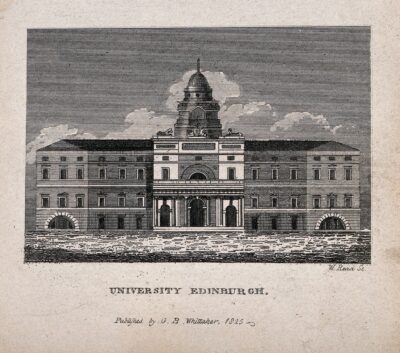
The moderate wing of the Church of Scotland raised legal accusations of atheism against Leslie in protest of his campaign for the Chair. The reason was that in a footnote of one of his treatises on natural science, he spoke favorably of the then-controversial Scottish philosopher David Hume. The affair pitted the moderate wing of the church against the evangelicals, who approved of Leslie’s appointment. Though Leslie was eventually appointed and the charges of atheism against him were dropped, the Leslie affair was influential in that it brought to the spotlight intellectual and legal disputes that were present in Scotland for some time.
One thinker, Thomas Brown, wrote to defend Leslie and Hume in 1805 and 1806; in 1806 he attempted to reconcile Hume’s account of cause and effect and contemporary Scottish views on religion in his Inquiry into the Relation of Cause and Effect. In her first philosophical treatise, Shepherd targets this very critique of Hume.
In 1808, Mary Primrose married Henry John Shepherd (1783–1855), son of Sir Samuel Shepherd, a widely respected lawyer in the UK. Henry John Shepherd was Member of Parliament for Shaftesbury as well as a poet and author known for A Summary of the law relating to the election of Members of Parliament (1825). Not much is known about the Shepherds’ marriage, but it was unusual in that Mary married late (at the age of 30) and did not wed an older man (her husband was 25 at the time). Henry John Shepherd did not have the same interest in philosophy as Lady Mary; instead, he was an amateur dramatist. He authored at least one play, titled The Countess of Essex, A Tragedy. It is unknown if this play was ever produced. All in all, McRobert reports that “regardless of the initial circumstances — happy, sad, or indifferent — Mary Shepherd was freer in marriage than most women of her day could boast” (McRobert 2002, p. 47). The contrast between Shepherd’s technical work and her husband’s artistic achievements can itself be seen as a rarity and inversion of social convention, demonstrating both Shepherd’s talent and passion for philosophy and the uniqueness of her marriage.
New research by Project Vox reveals that Mary Shepherd may have been engaged in an affair with James Bandinel, a civil servant and slave-trade abolitionist. The only mention of this affair appears in the Bandinel Family Papers, when Julia Le Mesurier (niece of James Bandinel) reports in a letter to her aunt: “when at [?Yundimoor], uncle James (James Bandinel) told my sisters that Lady Mary Shepherd wanted to run off with him, but he said, ‘No, Mary, we are very well as we are. Why cannot we go on so?’ She was so angry with his refusal that she quite quarreled with him & would not see him” (Bandinel Papers). While it is impossible to confirm whether this is a true story or just hearsay, the letter writer, Julia, seems to be well enough acquainted with both Mary Shepherd and her sister, Lady Arabella Primrose, to warrant further investigation of the relationship.
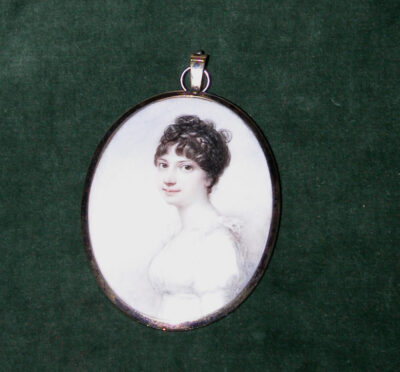
The Shepherds had three children. Their first child was Mary Elizabeth Shepherd, born in 1808, the same year Lady Mary married Henry John Shepherd. Henry Primrose Shepherd was born later in 1814 and Maria Charlotte Shepherd in 1815. Maria Charlotte only lived to be 15 and Henry John Shepherd suffered from serious health problems in his youth. Mary Elizabeth Shepherd went on to write the Brandreth (her married name) memoir, the main source for material concerning Shepherd’s biography. Lady Mary Shepherd spent the later part of her life in comfort and died in 1847 in Hyde Park in London. A letter between her and Robert Blakey, written during her final years, includes a complaint about becoming so ill she could not continue discussing philosophy (Blakey 1879, p. 160).
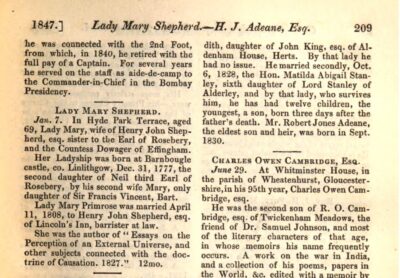
Lady Mary Shepherd is the author of two philosophical treatises: An Essay upon the Relation of Cause and Effect (1824) and Essays on the Perception of an External Universe (1827). She also composed shorter articles that articulate similar metaphysical positions to her two treatises. These include an essay published in Fraser’s Magazine for Town and Country (1832) and letters published in Parriana (1828) in which Shepherd defends her views on metaphysics against the naval officer and philosopher John Fearn.
The Brandreth memoir further claims that Lady Mary composed earlier, unpublished “metaphysical disquisitions” (Brandreth 1886, p. 28). One treatise sometimes attributed to Shepherd is the Enquiry respecting the Relation of Cause and Effect (1819). The Oxford Dictionary of National Biography, in an entry for her father, names Mary Shepherd as the author of three “philosophical treatises” (Courtney 2004, p. 2). According to Deborah Boyle, this attribution can be traced to a bookseller’s note in one of Cambridge University’s copies of Shepherd’s 1827 Essays on the Perception of an External Universe, which designated Mary Shepherd as the author of the 1819 book (Boyle 2020, p. 1–2)
In a recent article, Boyle contends that Shepherd was not the author of the 1819 Enquiry because the work was advertised in contemporary newspapers under the name of a Scottish architect, James Milne. Secondly, Boyle gives evidence that Shepherd was in London, rather than Edinburgh (where the publishing house was located), at the time of the Enquiry’s publication. Lastly, Boyle contends that the final section of the work, which concerns geology, has no other mention or parallel in the rest of Shepherd’s corpus. However, Shepherd was friends with Charles Lyell, a famous geologist, and mentions taking a course on geology.
Mary Shepherd’s philosophical works prove she was both engaged in the philosophical discourse of her time and actively pushing its boundaries. Robert Blakey, author of the encyclopedia History of the Philosophy of the Mind (1848), praised Shepherd’s philosophy. Charles Lyell, her contemporary, described Shepherd as an “unanswerable logician, in whose arguments it is impossible to find loophole or flaw” (Brandreth 1886, p. 29). Her philosophical treatises were not only read by the English and Scottish intelligentsia at the time, but, as these sources demonstrate, were also well respected. Mary Shepherd’s essays mostly concern the British Empiricist tradition, including thinkers such as Bishop Berkeley, Thomas Brown, Joseph Priestley, and David Hume. Shepherd was inspired by Brown’s 1806 Observations on the Nature and Tendency of the Doctrine of Mr. Hume, Concerning the Relation of Cause and Effect to compose her own works. According to Shepherd, Hume’s contention that cause and effect is only understood through habit and not reason reinforces the grounds for atheism and skepticism. Shepherd contends, however, that we can come to know the nature of cause and effect through the faculty of reason.
The Shepherds were distinguished within London’s academic circles. After her marriage, Shepherd reportedly became a lady of society and influence. Her academic circles included many of the most famous and best-known intellectual figures of the early 19th century in England and Scotland. Her home was the epicenter of intellectual circles during her time, and was likened to a salon for the well-educated to discuss and debate their ideas. Charles Babbage, a famous polymath and the “father of the computer,” engaged with Lady Mary in correspondence about contemporary philosophical issues; it is clear that they were also close friends.
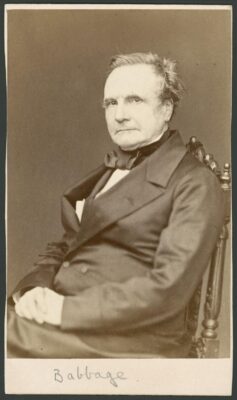
Additionally, Shepherd is known to have been close to political economist David Ricardo. Ricardo was one of the most influential figures in early economic theory, and his work spans the topics of foreign trade, rent, and others. While no correspondence between Ricardo and Shepherd is extant, Ricardo mentions in a letter to James Mill that the Shepherds stayed with him at his home, Gatcombe Park.
Beyond her close circle of friends, Mary Shepherd was well-regarded as a philosopher within educated circles. Samuel Taylor Coleridge wrote two unpublished poems about Shepherd in his notebooks, one of which reads:
“Lady Mary Shepheard,
As restless as a Leopard
Tho‘ not so lithe and starry,
Did wait on S. T. Coleridge
To learn the extreme polar ridge
Of Metaphysic Scholarship.
With Sall Atticum corn’d
With Paper-spice-pepper’d
With Book-garnish adorn’d
Enter Lady Mary Shepheard
Imbued with a taste for
Prose, poesy, paste
Metaphysics to lull her
Polemics
But what’s that to you?
She is a desperate Scholar
Like the heavens, deep blue!”
Despite the derogatory tone of this poem, it shows that Lady Mary was an influential figure among the intellectual elite of the period.
Others friends included the likes of Charles Lyell, Elizabeth Barrett Browning, Mary Somerville, William Whewell, Sydney Smith, and Thomas Malthus. Understanding Shepherd’s connections makes it clear that she was widely respected among the British cultural and social elite during her lifetime. The Brandreth memoir reports that William Whewell, while Master of Trinity College, Cambridge, used one of her works as a textbook for his students (Brandreth 1886, p. 29).
It is not documented, however, which of Shepherd’s works was used. Furthermore, Mary Shepherd’s writings received an entry in Robert Blakey’s aforementioned History of the Philosophy of the Mind. In his Memoir (1879), Blakey praises Shepherd for being “…without exception, the most eloquent female talker I have ever met with.”
The philosophy of Mary Shepherd gradually became overlooked in the Anglo-Scottish philosophical tradition, but there has been an increased amount of scholarship on her in the last twenty years. Recent studies are reviving the impact of her work. The writings of Mary Shepherd are also just now receiving new editions with in-depth indices, such as a new edition of Essays on the Perception of an External Universe by Antonia LoLordo (2020), as well as the recent edition of Lady Mary Shepherd: Selected Writings edited by Deborah Boyle (2018). Moreover, Shepherd has received considerable attention among scholars for her metaphysical views in recent years. For example, Jeremy Fantl’s 2016 article “Mary Shepherd on Causal Necessity” frames Shepherd’s anti-Humean arguments from a contemporary lens and argues that Shepherd pre-empted many modern views on induction and metaphysics. Deborah Boyle has also explored Shepherd’s arguments on the soul and the self, which moves away from simply framing Shepherd in relation to other (male) philosophers like Hume and Berkeley. McRobert has also greatly contributed to the known history of the life of Mary Shepherd and to the discussion of her philosophy. Enriching the field is also Martha Bolton’s scholarship on Shepherd, including chapters in Causation in Modern Philosophy (2011) and Feminist History of Philosophy: The Recovery and Evaluation of Women’s Philosophical Thought (2019).
It is perhaps ironic, as well as unfortunate, that although Shepherd was well-known and respected in her own time, no mature portrait has been identified. Shepherd’s impressive network of cultural and philosophical interlocutors throughout the United Kingdom surely made her a familiar face of her time. Our only confirmed image of Shepherd comes from a family portrait painted by Alexander Nasmyth circa 1788. Here we find an 11-year-old Mary Primrose standing second from the right with her sisters in a picturesque landscape set just outside Edinburgh at the Rosebery Estates. This view of the Estates, Shepherd’s birthplace and the painting’s current residence, provides some context of her social background by referencing her distinguished family, the Scottish Earls of Rosebery.
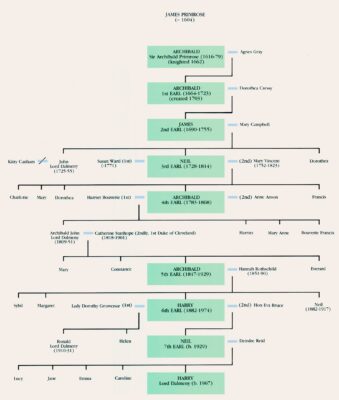
Most notably, Shepherd’s great-nephew, Archibald Philip, the fifth Earl of Rosebery, later became an active political figure of the Liberal party and served as the British Prime Minister from 1894–1895. However, it is important to qualify that the Nasmyth portrait gives virtually no sense of Shepherd as the person who later became a bona-fide philosopher conversant with the writings of some of the most important philosophers of the Early Modern period.
In trying to reconstruct a “picture” of Shepherd’s contributions to philosophy, it has therefore become crucial to draw on her far-reaching personal and professional connections. For example, the note written by Shepherd on a copy of her essays sent to Elizabeth Barrett Browning, or a reminder in William Godwin’s diary to “call on La. Ma. Shepherd,” are enriching features of Shepherd’s intellectual portrait. Together with contemporary maps and scenes of Edinburgh, Cambridge, and London, these images retrace Shepherd’s trajectory through the British Isles in the early 19th century.
Daniel Maclise’s late-1830s drawing of a popular salon in London led by Marguerite Blessington offers a glimpse into the kind of environment where Shepherd would have conversed with fellow bluestockings like Barrett Browning and Mary Somerville. In lieu of a single portrait, these images create a visual web of the spaces where Mary Shepherd became the figure reflected in her philosophical writings.
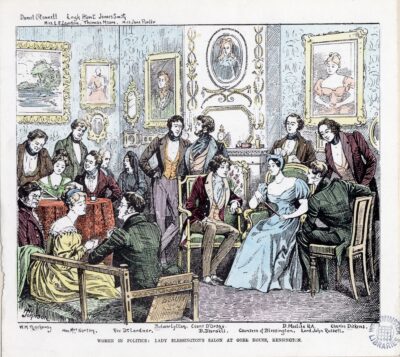
Shepherd’s legacy has proven resilient up to the present day. In 2019, students at Edinburgh University started a “change.org” petition calling for the erection of a statue in her honor. Their petition rightfully asserts Shepherd’s importance alongside fellow Scottish intellectuals like David Hume and Adam Smith, whose statues are both established landmarks in Edinburgh.
This modern reference calls attention to the ongoing under- and mis- representation of women in philosophy; it gestures toward a larger discussion of how best to commemorate women’s intellectual contributions to history. Recent controversy has also surfaced concerning the statue of Mary Wollstonecraft erected in North London this past November 2020.
In the case of Mary Shepherd, the question is further complicated by her lack of a portrait. If her statue were erected in the Scottish capital, what would it look like? Without a mature portrait, or enough visual description from textual sources to serve as a reference, how should one depict a female philosopher? Considered in this way, the case of Shepherd’s statue also touches on the paradox of women’s visual representation in art history—that is, the use of their bodies to symbolize liberal ideals of freedom, universal knowledge, and equality—ideals from which they have largely been excluded.
The life of Mary Shepherd was characterized by philosophical thought, writing, and discussion. Not only was she an influential philosopher in her writing, she was a member of a close-knit group that shared discoveries and opinions about their diverse subject area. From the mathematics of Charles Babbage and the economics of David Ricardo to the poetry of Samuel Taylor Coleridge, each was influenced by Shepherd in some way through their shared social circle and correspondence. There is still much to discover about her life and it is a rich area of future scholarship deserving of continued attention.
For image sources and permissions see our image gallery.
1.2 Chronology
| Date | Event |
| 31 December 1777 | Lady Mary [née Primrose] Shepherd is born at Barnbougle Castle, just outside of Edinburgh in Dalmeny parish as the second daughter of Neil Primrose, third Earl of Rosebery, and his second wife Mary, the daughter of Sir Francis Vincent of Stoke d’Abernon. |
| 1805 | John Playfair, chair of the University of Edinburgh’s Mathematics department, resigns and recommends the appointment of John Leslie as his replacement. Leslie’s appointment is vehemently opposed by the Church of Scotland because he wrote favorably about David Hume. |
| 1806 | Thomas Brown publishes Observations on the Nature and Tendency of the Doctrine of Mr. Hume concerning the Relation of Cause and Effect, a longer version of an 1805 pamphlet of the same name. |
| 1808 | Shepherd marries London barrister Henry John Shepherd. |
| 1824 | Shepherd publishes An Essay Upon the Relation of Cause and Effect Controverting the Doctrine of Mr. Hume Concerning the Nature of that Relation; with Observations Upon the Opinions of Dr. Brown and Mr. Lawrence, Connected with the Same Subject. |
| 1825 | The earliest surviving correspondence between Shepherd and Charles Babbage. |
| 1827 | Shepherd publishes Essays on the Perception of an External Universe and Subjects Connected with the Doctrine of Causation. |
| 1828 | Shepherd publishes “Observations on Mr. Fearn’s lines of the human mind” in Parriana: or Notices of the Rev. Samuel Parr, L.L.D.; and “LXIII. On the Causes of Single and Erect Vision” in The Philosophical Magazine. |
| 1832 | Shepherd publishes “Lady Mary Shepherd’s Metaphysics” in Fraser’s Magazine for Town and Country. |
| May 1837 | The earliest surviving correspondence between Shepherd and William Whewell. |
| 7 January 1847 | Shepherd dies at age 69. |
2. Primary Sources Guide
2.1 Major Works
Shepherd, Mary. 1824. An Essay Upon the Relation of Cause and Effect Controverting the Doctrine of Mr. Hume Concerning the Nature of that Relation; with Observations Upon the Opinions of Dr. Brown and Mr. Lawrence, Connected with the Same Subject. T. Hookham, London.
—. 1827. Essays on the Perception of an External Universe and Subjects Connected with the Doctrine of Causation. John Hatchard and Son, London.
—. 1832. “Lady Mary Shepherd’s Metaphysics.” Fraser’s Magazine for Town and County.
—. 1828. “Observations on Mr. Fearn’s Lines of the Human Mind.” Parriana: Or Notices of The Rev. Samuel Parr, L.L.D.
—. n.d. “On the Causes of Single and Erect Vision.” The Philosophical Magazine and Annals of Philosophy.
—. 1828. “On the Causes of Single and Erect Vision.” The Kaleidoscope; or, Literary and Scientific Mirror vol. 9, no. 420: 13, and vol. 9, no. 421: 22–3.
2.2 Letters
Letter from Mary Shepherd to Charles Babbage. British Library, Babbage Correspondence, MSS 37183, f. 204, 18 November 1825.
Letter from Mary Shepherd to Charles Babbage. British Library. Babbage Correspondence, MSS 37201, 1832.
Letter from Mary Shepherd to William Whewell. Trinity College, Cambridge. Papers of William Whewell (1794-1866) Master of Trinity College, Cambridge, Add. MS.a.21266, 1837.
Letter from Mary Shepherd to William Whewell. Trinity College, Cambridge. Papers of William Whewell (1794-1866) Master of Trinity College, Cambridge, Add. MS.a.21266, 1838.
Letter from Mary Shepherd to William Whewell. Trinity College, Cambridge. Papers of William Whewell (1794-1866) Master of Trinity College, Cambridge, Add.MS.a.21266, 1840.
Shepherd to Whewell. Master and Fellows of Trinity College, Cambridge, Add.MS.a.212/66-68, n.d.
2.3 Other Notable Sources
Bandinel Family. 1763. Papers, 1763-1940; (Bulk 1763-1906). https://find.library.duke.edu/catalog/DUKE000842407.
Barker, Edmund Henry to Browning, Elizabeth Barrett, 8 September 1828. In Armstrong Browning Library – The Browning Letters. https://digitalcollections-baylor.quartexcollections.com/documents/detail/8-september-1828.-barker-edmund-henry-to-browning-elizabeth-barrett./335452
Blakey, Robert. 1850. A History of the Philosophy of Mind: Embracing all Writers on Mental Science from the Earliest Period to the Present Time. London: Longman, Brown, Green, and Longmans.
Blakey, Robert, Henry Miller. 1879. Memoirs of Dr. Robert Blakey, Professor of Logic and Metaphysics, Queens’s College, Belfast … London: Trübner & Co.
Brandreth, Mary Elizabeth. 1888. Some Family and Friendly Recollections of 70 years of Mary Elizabeth Brandreth, widow of Henry Roland Brandreth, etc. C. Hooker, Westerham.
Brown, Thomas. 1818. Inquiry into the Relation of Cause and Effect. Edinburgh: Archibald Constable.
—. 1805. Observations on the Nature and Tendency of the Doctrine of Mr. Hume concerning the Relation of Cause and Effect. Edinburgh: Mundell and Son.
—. 1806. Observations on the Nature and Tendency of the Doctrine of Mr. Hume concerning the Relation of Cause and Effect. 2nd edition, enlarged. Edinburgh: Mundell and Son.
Browning, Elizabeth Barrett to Barker, Edmund Henry, 27 August, 1828. In Armstrong Browning Library – The Browning Letters. https://digitalcollections-baylor.quartexcollections.com/documents/detail/27-august-1828.-browning-elizabeth-barrett-to-barker-edmund-henry./335437
Fearn, John. 1817. A letter to Professor Stewart, on the objects of general terms, and on the axiomatical laws of vision.
—. 1828. ‘Reply to the criticisms of Lady Mary Shepherd’s on the ‘First Lines’: With observations on her Ladyship’s views with regard to the nature of extension as contained in her essays on the perception of an external universe.” In E.H. Barker, editor, Parriana: or Notices of the Rev. Samuel Parr, L.L.D., pp. 628–650. London: Henry Colburn.
Lawrence, William. 1819. Lectures on Physiology, Zoology, and the Natural History of Man. London: Printed for J. Callow.
The Works and Correspondence of David Ricardo, ed. Piero Sraffa with the Collaboration of M.H. Dobb (Indianapolis: Liberty Fund, 2005), Volume VIII.
3. Secondary Sources Guide
“Lady Mary Shepherd.” 1847. The Gentleman’s Magazine: And Historical Review, July 1856–May 1868: 209.
Atherton, Margaret. 1996. “Lady Mary Shepherd’s Case Against George Berkeley.” British Journal for the History of Philosophy 4 (2): 347–366.
—. 2005. “Reading Lady Mary Shepherd.” The Harvard Review of Philosophy 8, no. 2: 73–85.
Bolton, Martha. 2011. “Causality and Causal Induction: The Necessitarian Theory of Lady Mary Shepherd.” In Causation and Modern Philosophy, edited by Keith Allen and Tom Stoneham, 242–261. New York: Routledge.
—. 2019. “Lady Mary Shepherd and David Hume on Cause and Effect.” In Feminist History of Philosophy: The Recovery and Evaluation of Women’s Philosophical Thought, edited by Eileen O’Neill and Marcy P. Lascano, 129–152. Cham: Springer.
Boyle, Deborah, ed. 2018. Lady Mary Shepherd: Selected Writings. Exeter: Imprint Academic. https://find.library.duke.edu/catalog/DUKE009141371.
—. 2017. “Expanding the Canon of Scottish Philosophy: The Case for Adding Lady Mary Shepherd.” Journal of Scottish Philosophy 15 (3): 275–293.
—. 2020. “A Mistaken Attribution to Mary Shepherd.” Journal of Modern Philosophy, 2, no. 1. DOI: http://doi.org/10.32881/jomp.100
—. 2020. “Mary Shepherd on Mind, Soul, and Self.” Journal of the History of Philosophy 58, no. 1: 93–112.
—. 2020. “Mary Shepherd on the Meaning of ‘Life.’” British Journal for the History of Philosophy special issue on Women Philosophers of the Nineteenth Century. https://www.tandfonline.com/doi/abs/10.1080/09608788.2020.1771271
Fantl, Jeremy. 2016. “Mary Shepherd on Causal Necessity.” Metaphysica 17 (1): 87–108.
Kensington Society. 1983. Annual Report 1983–1984. Kensington Society, London.
Landy, David. 2020. “A Defense of Mary Shepherd’s Account of Cause and Effect as Synchronous.” Journal of Modern Philosophy 2, no. 1: 1–15. DOI: http://doi.org/10.32881/jomp.46
LoLordo, Antonia. 2019. “Mary Shepherd on Causation, Induction, and Natural Kinds.” Philosophers’ Imprint 19, no. 52. www.philosophersimprint.org/019052/
—. 2020. Mary Shepherd’s Essays on the Perception of an External Universe. New York: Oxford University Press.
McRobert, Jennifer. 2000. Philosophical Works of Lady Mary Shepherd Bristol: Thoemmes. https://find.library.duke.edu/trln/UNCb3804742.
—. 2002. “Mary Shepherd and the Causal Relation.” Revised 2014. http://philpapers.org/rec/MCRMSA.
Paoletti, Cristina. 2011. “Restoring Necessary Connections: Lady Mary Shepherd on Hume and the Early Nineteenth-Century Debate on Causality,” in Hume, Nuovi Saggi=Hume, New Essays, Padova: Il Poligrafo: 47–59.
Rickless, Samuel C. 2018. “Is Shepherd’s Pen Mightier than Berkeley’s Word?” British Journal for the History of Philosophy 26, no. 2 (2018): 317-330.
Waithe, Mary Ellen. 2004. “Canon Fodder: New Works by and about Women Philosophers.” Hypatia 19 (2): 134–149.
4. Philosophy & Teaching
As described in the biography, Mary Shepherd’s philosophy begins with the “Leslie affair.” The affair, instead of an isolated event, was a product of a larger movement of intellectual disagreements over the writings of David Hume in Scotland during this time period. Most notably, Thomas Brown took up a defense of David Hume and Leslie in the period leading up to the publication of Shepherd’s first work, An Essay upon the Relation of Cause and Effect (1824).
4.1 An Essay upon the Relation of Cause and Effect
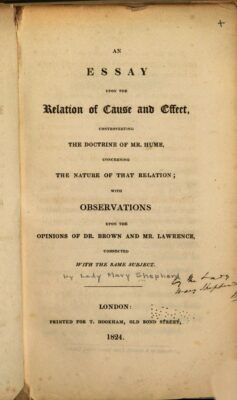
Shepherd aptly begins the book with a list of disagreements with Hume and Brown:
- Reason, and not habit or custom, leads to knowledge – everything that exists must have a cause.
- Reason forces the mind to perceive that like causes produce like effects.
- A new definition of cause and effect is needed to replace Hume’s.
- Hume’s definition of cause and effect is faulty.
- Nature cannot alter its course without a contradiction in terms.
Shepherd’s project in dissecting Humean accounts of causation and induction is threefold: she believes that cause and effect are synchronous, that we come to know causes and effects through reason, and that nothing can come into existence without a cause. Hume believes that we come to know about the nature of cause and effect through experience, and not through reason. All inductive inferences, governed by matters of fact and not relationships of ideas, depend on the assumption that the future will resemble the past. Shepherd’s goal is to show that these views of nature and causation are wrong, and that we can instead come to make causal inferences based on reason alone and not merely belief.
In order to begin to undermine Hume’s skepticism about causation, Shepherd first contends that viewing causes and effects as separate entities is merely a distinction of semantic origin that does not reflect reality. Her specific contention is that cause and effect should not be defined as two temporal events in succession. She reasons that viewing a cause as antecedent to an effect implies that there is a slice of time in which there is indeed a cause but the effect is held in suspense. Shepherd believes this is a semantic mistake on the part of Hume, and produces the problem of induction elucidated in Hume’s circle because this definition is wrong.
From here, Shepherd redefines what causes and effects actually are so as to resolve the problem of induction. She labels objects as “masses of qualities” that are perceived with the senses. For instance, leaves are green, and this greenness is one of the qualities that makes up the object of a leaf. What we see as changes are qualities being added, changed, or subtracted from the objects we observe. This change in qualities is what Shepherd defines as cause and effect. An object has a set of qualities, and through mixture with another object or some other sort of change, a new object with new qualities arises as the effect. This effect occurs synchronously – when two objects mix or conjoin, they together form a union which is a third, new object. This definition accomplishes Shepherd’s vision of causes being synchronous. This can be likened to a chemical reaction: two atoms can interact to create a molecule containing new properties and qualities.
Next, Shepherd attempts to prove that we achieve knowledge of cause and effect through reason, rather than relying on custom or habit, as Hume argues. To do this, she advises us to consider the phenomenon of sight: when we open our eyes we can see, and when we close them, we cannot see. Shepherd writes “One trial would be enough, under certain known circumstances. Why? not from ‘custom’, because there has been one trial only; but from Reason, because vision not being able to produce itself, nor any of the surrounding objects by the supposition; it is the Eye which must necessarily perform the operation…” (Shepherd loc, 749). For the inference to rely on custom or habit, a number of trials exhibiting some pattern would be required. Instead, we observe change through the change in qualities in objects that we observe and, founded on the principle that no effect or change can come into existence without a corresponding cause, each change we experience must be, in some manner, caused. What this shows is that the change in vision when opening and closing our eyes is not understood through habit, but from the recognition that the change in vision must be produced by something; given that there is no vision when the eye is covered, the organ which produces vision must be the eye. We make a rational inference, rather than relying on custom.
So far, we’ve seen Shepherd redefine cause and effect to be a synchronous interaction, and how reason and not custom or habit can be used to understand causal interactions. What is left to prove from her initial list is to define her causal principle, that like causes produce like effects, and to use this principle to show how changes in the course of nature, which Hume contended were possible, is a contradiction in terms and therefore impossible.
In order to do this, Shepherd implores us to imagine snow falling from clouds onto the ground, but in this case the snow has the taste of salt. Hume contends that this situation is possible. In Hume’s understanding, we have no knowledge of any necessary connection between cause and effect, we know only through the habit of repeated experience that snow does not taste like salt. In this example, we would have to concede that the snow could taste like salt because the future does not necessarily have to resemble the past.
Shepherd, however, thinks that snow cannot suddenly acquire the taste of salt. She says that if such a snow-like substance tastes of salt, it would require a new name because it is a different object entirely. This is so because, by her account, there has been a change in the qualities of the object, snow, and this change means that the snow-like substance we perceive is no longer snow, but some other object. In this understanding, objects cannot take on new qualities without themselves being different objects altogether. What this means is that the being of any object is tied to the qualities that define it (remember, Shepherd defines objects to be masses of qualities). Any change in the qualities of objects is the result of a causal interaction, so the change in the qualities of snow is a causal interaction. This change, Shepherd contends, can be understood through reason as described earlier.
This realization, along with Shepherd’s account of causation, brings us to her causal principle: that like causes produce like effects. This can be applied to the snow example: snow always tastes like snow and not salt. This is her capstone in the argument against a Humean account of inductive inferences built into causation. We can apply this principle based on reason alone because, if snow suddenly gains the quality of saltiness, then we can reason that this substance is no longer snow because it no longer produces the like effect of the normal taste of snow.
The proof of Shepherd’s causal principle is as follows:
- If we view causal interactions as synchronous, effects are merely dependent outcomes of the interaction that produces them. Shepherd models her understanding of a causal interaction like a mathematical equation:
A x B = C. - In this understanding, effect C can be seen as always in existence as a potentiality of the causal interaction of objects A and B. Shepherd takes this to mean that the “future is included in the past” (Shepherd loc 1523).
- Thus, it is a contradiction to say that A x B does not = C, because this would imply the creation of a new quality (Shepherd thinks that new qualities cannot come into existence without being caused).
- It is thus a contradiction to say that like causes do not produce like effects.
This shows that a violation of Shepherd’s causal principle is a contradiction in terms and, therefore, false. Her causal principle (like causes produce like effects) is again in the service of reason as our means to understand the world. Shepherd’s causal principle is a rebuttal to Hume’s assertion that induction is based on the unjustified assumption that the future will resemble the past. For Shepherd, the future must resemble the past to not be a contradiction in terms. In this way, Shepherd proves that we can use reason to come to an understanding of induction.
The emphasis that Shepherd places on synchronicity has to do with her overall attempt to show that cause and effect are inseparable from one another. Since an effect is only brought about in the conjunction of its causes, a process that happens simultaneously instead of successively, there is no way that a cause could be removed from an object and still have a causal relation. Lolordo (2020) likens Shepherd’s conception of cause and effect to that of a chemical synthesis: two entities conjoin and together, synchronously in their mixture, create some third thing (the effect), but you cannot remove one part of that synthesis and still have the synthesis. An effect only arises in this synchronous conjunction and is therefore wholly dependent on, and indistinguishable from, the combination of causes in all metaphysical respects (including temporality).
Inherent in Shepherd’s philosophy is the idea of God and determinism. Her conception of cause and effect does not allow for objects, qualities, or effects to come into the world uncaused. Since there are objects and qualities in the world, this leaves room for God to create the world in which we live. Shepherd’s causal axiom, then, is that no qualities or objects can come into the world uncaused. This stands in contrast to Hume’s conception of cause and effect, which Shepherd describes as atheistic. God, in her understanding, is a being who is always existing and thus never caused; this exempts God from her causal principle.
In summary, Shepherd attempts to solve skeptical problems in induction by defending reason as our main guide to the world and our interactions in it. She redefines cause and effect, shows that this new definition implies that cause and effect are synchronous, shows that it is a contradiction to say that the future does not behave like the past, and then presents a causal principle that resolves the conflict in Hume’s skepticism. Jeremy Fantl in his article “Mary Shepherd on Causal Necessity,” points out that “Shepherd’s argument anticipates metaphysical views that have recently been marshalled in the service of anti-Humean conclusions similar to Shepherd’s…” (Fantl, 89). For this, Shepherd is deserving of continued scholarship and recognition.
4.2 Essays on the Perception of An External Universe
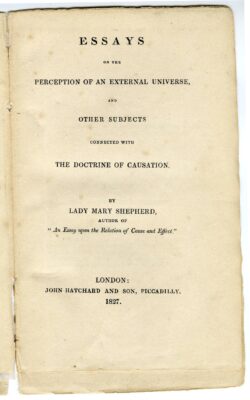
Shepherd’s Essays on the Perception of An External Universe (1827) is her second main work. The Essays is a highly readable series of discussions of a number of important issues from her day, including the question of external world skepticism, the mind-body relation, Hume’s skeptical remarks about causation, Berkeley’s idealism, the nature of time, and Newton’s theory of universal gravity. Since she discusses such a wide range of prominent philosophical topics, the Essays (or sections of it) lends itself to integration into a syllabus.
In the Essays, Shepherd argues that Hume’s external world skepticism and Berkeley’s idealism are equally mistaken. First of all, she argues that reasoning convinces us of the existence of external objects, by which she means that objects are distinct from our perceptions of them. She therefore disagrees with Hume’s view that reason does not convince us of the existence of external objects—a parallel to Hume’s view in the Enquiry Concerning Human Understanding that reason does not convince us about causal relations (rather, the latter is due to habit or “custom”). Second of all, she argues that although we “immediately know nothing but our sensations,” (Shepherd 2020, 20) a view that might please Berkeley, idealism is not warranted because we have mediate knowledge of external objects. There are in fact external objects—items that are distinct from our sensations—which cause our sensations, and because they cause our sensations, we know them mediately. If they never caused any sensations, we would not use reason to infer their existence; hence, the knowledge is mediated by our sensations. However, we do not achieve our knowledge of external objects immediately through our sensations; we must use reason to infer them. Therefore, idealism is inaccurate because there are in fact external objects that are independent of the mind, and Hume’s skepticism is also inaccurate because although we cannot know those objects immediately, we can infer their existence using reason on the basis of our sensations. That description encapsulates her overall view in this text.
Before we can delve into the details of Shepherd’s ideas in the Essays, at least two caveats are in order. The first is terminological: Shepherd uses the word “sensation” as a technical term. It does not mean what we now mean by sensation, but rather has a much broader definition similar to the meaning of “idea” in Locke’s Essay. In particular, Shepherd says that there are at least four types of sensation (Shepherd 2020, 136): first, we have sensations of sensible qualities (we smell the rose, see its scarlet color, etc.); second, we have what she calls sensations that are ideas of memory; third, we have sensations that are ideas of imagination; and finally, we have sensations that are ideas of reason. Her usage here is broader than in contemporary usage because she includes amongst her “sensations” a wide range of what we would now call mental states, including memories and ideas employed during reasoning. This is crucial to remember as one reads the Essays so as to avoid confusion. If one is familiar with early modern philosophy, one might read “idea” whenever Shepherd says “sensation,” and if one is familiar with contemporary analytic philosophy, one might read “mental state” in its place. What she really means by “sensation” is something like an item of awareness, since it includes thoughts that a person has when reasoning about something (perhaps trying to make an inference) along with memories that they have.
A second caveat may help readers to avoid confusion. Shepherd agrees with the early modern view—one defended famously by Berkeley, but held by others as well—that nothing can be like an idea, or in her parlance, a sensation, except another idea (sensation). What does that mean? At first glance, this might be confusing due to the broad meaning of “sensation” just discussed. After all, if I have what Locke would call an idea of the Eiffel Tower (which Shepherd would call a “sensation,” or an idea of memory of it) after my trip to Paris, surely my idea is like the Eiffel Tower in some sense. After all, what makes it an idea of the Eiffel Tower and not an idea of the Tower of London? Presumably it is not merely the fact that my idea was caused by the Eiffel Tower and not by the famous London landmark (let us stipulate that I have never been to London, or seen pictures of it, etc.). That may be true, but it must also be true that if my idea of the Eiffel Tower is any good, it looks like it! It is a decent likeness of it: when I remember it, I think of a giant steel structure with a certain shape, etc. And we could determine that to be the case in a simple way, say by having me draw the Eiffel Tower from memory and then showing it to a Parisian friend—if she looks at the drawing and says, “oui, c’est la Tour Eiffel,” then we are set. Obviously, if ideas or sensations are representational, then they can be likenesses of their objects, and in that sense, they can be like something that is not an idea or a sensation. Shepherd does not deny that at all. She is simply saying the following: a sensation is an item of awareness, a conscious mental state, and such states, leaving aside their representational aspects, are not like anything except other conscious states. One might still wonder about this notion, but for Shepherd’s purposes, that would not be especially pertinent here because in the Essays her goal is to agree with her opponents—chiefly Hume and Berkeley—when she is comfortable doing so in order to sharpen her disagreements with them (Shepherd 2020, 197–198). For these reasons, she wishes to agree with this widespread view.
What, then, are the details of Shepherd’s position in the Essays, from which she intends to express her disagreements both with Hume and with Berkeley? One way to understand Shepherd’s overarching view in this text is as follows: objects are what we might call phenomena. They are phenomena in the sense that they are neither entirely mind-independent, nor entirely mind-dependent. They are, as she says, “compound beings” because they involve a contribution from the senses (and/or the mind) as well as a contribution from the “unknown object,” which is the cause of our sensations. That is, they are “at once ideas of the mind and exist independently of it” (Shepherd 2020, 179). She invites us to consider a specific example, say a table in my office. Now when I sit at the table, I notice that its surface is smooth, it is dark brown and wooden, it may smell a bit of the stain I added to it last week, and so on. Obviously, when I am describing my table to my friends, I use these kinds of descriptors—that is, I use my sensations to describe the table. And that makes good sense, not least because I think that if my friends were to sit at the table here with me, then they would have the same range of sensations that I have now. However, Shepherd’s view is that ordinary people think of the table as being the thing that I perceive and then think of the thing that I perceive through that range of sensations that I receive when I sit at the table. That is perfectly fine for ordinary life, and indeed, entirely natural in a certain sense. In a philosophical context, however, when we are trying to determine (e.g.) whether to agree with the views that Berkeley outlines in his Three Dialogues or his Principles of Knowledge, we must be more precise. And to be more precise, Shepherd argues, we ought to think in the following terms: the item that I know and love as my “table” is in fact a compound being that consists of a contribution from an unknown object, the cause of my sensations on the one hand, and a contribution from my senses on the other hand. The unknown object is the cause of my sensations, which latter are the effect, but the “table” should not be identified with either of these. Rather, it is the compound being that lies at the intersection of the cause and the effect. The “table” is not identical to the unknown object that causes my sensations; but also, and contrary to ordinary parlance and ordinary thinking, it is not identical to the set of sensations that are caused by that unknown object (recall that nothing is like a sensation but another sensation, so tables are not like sensations). Rather, the “table” is the compound being that lies at, or arises from, the interaction of those two things.
Hence in a deep sense, according to Shepherd, the table is neither real nor ideal. It is not real in the sense that it is not entirely mind-independent, because it depends in part on my senses, on the string of sensations that the unknown object underlying the table I perceive causes. As she often reminds us, I cannot have any sensations without the “mechanisms” of my senses. However, the table is also not ideal: pace Berkeley, it does not consist solely of my “ideas” or of my series of sensations, because it depends not merely on my senses, but also on the unknown object underlying the table that causes those sensations by interacting with my senses. Moreover, Shepherd adds a crucial twist: the object that causes my sensations, that which underlies the table, is “unknown” in precisely the sense that it is not perceived. It causes my perceptions, it is true, but it is not perceived, she thinks, because it is reason that tells me that such an object is there. Perhaps the best way to understand this last point is to say that for Shepherd, what I see is the table, but reason tells me that in seeing the table—which means, in having a series of perceptions of a wooden, brown, thing—I am having sensations that must be caused by something. That is, it is reason, and not my senses, that tells me about the unknown object underlying the table as the cause of my sensations.
Why does she say that the object, the cause of my sensations, is “unknown” or “unperceived”? One might object to this idea as follows: surely, I do perceive it, since it causes my sensations! And perception is obviously a causal process: since the object causes me to have a string of sensations, does it not follow that in having those sensations, I am perceiving that object?
In response, Shepherd might borrow the famous phrase used by Berkeley: one ought to speak with the vulgar and think with the learned. In ordinary contexts, of course, one does indeed say that one perceives things like tables. That expression is fine as far as it goes in ordinary contexts; but in a philosophical context, it is not precise. The reason is that the table that I ordinarily say I perceive is in fact the result of two things working in concert: an object that serves as a cause of my sensations, and the sensations themselves, which are the effect. It is more precise, at least in a philosophical context, to say instead that an unperceived material body causes my sensations (see Shepherd 2020, 697–8). What the philosopher (following Shepherd) realizes is that in ordinary contexts, we say that we see a table, and then when we say what the table is, we refer to our sensations—we say, e.g., that is it is brown, or that it has a rough surface, and so on. We conflate our sensations of the table with the object itself. That is problematic philosophically, she thinks, because the table itself is not like—it is not similar to—the table sensations that it causes. Hence, she prefers to say that the object which causes our sensations is unperceived, and once we have the sensations that it causes, we obtain things like the table.
We might say that for Shepherd, ordinary objects like the table in my office are compound beings both ontologically and epistemically. The table is ontologically compound because it consists of a relation between a string of sensations as an effect and a cause of those sensations. Of course, ordinary people do not think of tables in that way! However, according to Shepherd, that is the correct philosophical view. We know that she thinks of her view as involving an ontological component because she says explicitly that things like my table are “compound beings.” So ontologically speaking—that is, bracketing our knowledge for a moment—it is correct to say that if you take an unknown object and present it to a perceiver, you will have a table. The object underlying the table and its perceivable qualities causes a series of sensations associated with the table. Intriguingly, she also seems to think that if we analyze our knowledge, then the table is also epistemically compound. It is epistemically compound because it arises from a complex interaction of the senses and of reason. Now, without the senses, there would be no table—nothing would appear to me as brown and wooden and so on. That is, I obviously require my senses to have a series of sensations. But without reason, I could not attribute my sensations (brown, wooden, etc.) to any cause. I would simply have a series of sensations, and although it might be true that that series was in fact caused by something else in the world, I would not know that fact, for Shepherd thinks that it is reason, and not my senses, that underlies my knowledge of external objects. I infer their existence using reason; I do not simply perceive their existence.
Shepherd sometimes speaks of young children as learning about the things around them, which might provide a useful avenue for understanding her idea that ordinary things are “compound beings.” Suppose an infant has the full range of senses but is not yet employing reason in any way. For Shepherd, if that child were to encounter the table in my office, she would of course see it, perhaps touch it, etc. But for the child, this would merely be a string of sensations, and as such, they would not differ at all from a stomach ache, a pinch in her left knee, or the like. That is, the string of sensations would not be attributed to anything else by the infant. Now of course, her parents would know that the table was causing her sensations, unlike in the case of her stomach ache. But she would not yet attribute the sensations to anything but herself; she would not infer anything about them, she would simply have the sensations. And it is not far-fetched to think that something like this scenario actually occurs with young children. Once the child begins to reason, she will begin to attribute some of her sensations to external things, that is, to something else other than herself, rather than merely having the sensations and reacting to them, perhaps by crying or smiling, etc. She will distinguish a stomach ache from a perception of a wooden table, and will infer that the table caused her sensation in one case, but not in the other. In this way, Shepherd’s view is sophisticated: because things like tables are epistemically compound, infants do not perceive objects simply by opening their eyes, or hearing things, or touching them. Rather, they merely have a series of sensations when they open their eyes or touch something; that is merely step one. After receiving a series of sensations, they must then complete step two by employing reasoning to infer that something external to them is causing their sensations. Newborn babies perhaps lack the capacity to reason in this way, but they soon gain it. In that sense, Shepherd is arguing against what we might call a kind of naïve empiricism. We get sensations merely by opening our eyes, it is true, but we do not thereby obtain objects. To obtain an object, we must employ not only our senses, but reason as well, and indeed, the two must work in concert if the rich world of objects we all navigate every day is to appear to us. As Shepherd says, in the normal case, once the infant grows up, reason and the senses work seamlessly together – so seamlessly, in fact, that it is only upon analysis that we can grasp the distinct contributions that the senses and reason make to our perceptions of the world.
It seems reasonable, therefore, to insist that one should not categorize Shepherd as either an idealist or a realist in the Essays. She is highly critical of the kind of idealism defended by Berkeley, on various grounds. In Shepherd’s view, Berkeley fails to grasp that reason indicates there must be some cause for our string of sensations. Otherwise, our ideas or sensations would arise from nothing, which is a violation of the kind of fundamental causal principle that Shepherd outlines in her work on causation. Pushing aside the details of her criticism of Berkeley for the moment, it is clear that she does not regard herself as defending idealism in this text. The important point here is that she also resists realism. That is, she does not avoid Berkeley-style idealism by simply endorsing a kind of realist view, perhaps of the kind that Hylas defends at one point or another in the Three Dialogues. Shepherd instead says the following: reason teaches us that there must be some unknown object that is the cause of our sensations, it is true, but we cannot identify that unknown object with objects in the usual sense. That is, although we might say that the unknown object is real in the sense of being fully mind-independent, Shepherd nonetheless rejects the idea that realism is the full story. She makes it perfectly clear that the unknown object we postulate due to reasoning should not be conflated with the objects that we know and love, like the table in my office. Instead, the table in my office is not real in the philosophical sense, i.e., it is not mind-independent. On the contrary, it depends in part on the mind because it depends in part on my series of sensations. It is “compound” in her terminology, as noted above. Hence tables and chairs are neither real per se nor ideal per se, but rather phenomena, namely, a mixture of ideal and real elements. In that specific sense, neither idealism not realism fully captures her views in the Essays.
In addition to defending the views presented above, Shepherd tackles many other problems in this work, including the nature of time, the mind-body relation, questions about the philosophical import of dreaming, the views of other figures from her day. Her discussion of dreaming is especially intriguing, and ought to interest contemporary readers who have studied John McDowell’s influential discussion in Mind and World. Dreaming was put onto the agenda of early modern philosophy by Descartes’s famous treatment of it in the beginning of his Meditations in First Philosophy. In that text, Descartes presents what McDowell calls the “highest common factor” view of epistemology in the case of dreaming (McDowell 1994, 113). The idea is roughly this: according to Descartes, if I have a dream of eating an ice cream sundae, and then if I actually eat an ice cream sundae the next day, then I have the same set of ideas—Shepherd would call them “sensations”—in each case. That is precisely why I may be unable to distinguish between a dream and the real experience. The dream and the experience are treated as having a highest common factor in the sense that they are understood to involve the same set of ideas (or “sensations”). Then one of the main problems of modern epistemology can be articulated as follows: how can I distinguish between the dream and the real experience? Descartes presents a view of how to do so later in the Meditations (it involves a divine rescue).
However, in a fascinating move, Shepherd rejects the premise of Descartes’s discussion. That is, she rejects the highest common factor view at the outset, thereby avoiding a basic presumption underlying much of modern epistemology. In her discussion of dreams, Shepherd implies that a dream about eating an ice cream sundae and an experience of eating a sundae are in fact different. They are distinct effects because they have different causes. It is obvious that they have different causes: the experience is caused in part by an actual ice cream sundae and the dream is not. What she adds to that obvious thought is the primacy of her understanding of causation. She argues that, in order for the dream and the experience to be the “same effect,” they would have to have the same cause or a “precisely similar” one (Shepherd 2020, 92–93). Since they do not have the same cause—indeed, since their causes are entirely different, and not similar at all—they must not be the same effect. That is, since “like effects must have like causes,” she rejects the idea that we can use the phenomenon of dreaming to undermine her view that we need not worry about external world skepticism. Of course, she does not deny that I can (e.g.) have a dream about eating an ice cream sundae that seems real. She simply denies that this fact gives me a reason to endorse the philosophical view—one found in Descartes and many others—that dreaming and genuine experiences involve the same cognitive states (the highest common factor). This is a specific example in which we see how her understanding of causation and of causal relations helps to shape her theory of perception, and highlights a respect in which Shepherd presents a distinctive philosophical voice at the end of the early modern period.
4.3 Philosophical Context
In order to create a holistic and nuanced understanding of Mary Shepherd’s contribution to philosophy, we need to recognize the philosophical context in which she wrote. We will first take a closer look at Shepherd’s relationship to the philosophical traditions of Hume’s skepticism and Berkeley’s idealism. Although there are important differences between these main schools of thought that inspired Shepherd’s work, we can observe a common denominator among a few of them. Prominently, Hume’s skepticism, Berkeley’s idealism, and the Scottish common-sense school all oppose the foundation for the causal relation and for the belief in a mind-independent external world, which are central pursuits of Shepherd. Furthermore, Shepherd shows knowledge in varying degrees of the philosophy of Locke, Leibniz, Kant, and various French thinkers.
David Hume
The writings of the Scottish philosopher David Hume (1711–1776) were the topic of much heated discussion in late 18th and early 19th-century intellectual Edinburgh. As we have seen in the Biography section, the controversy of the Leslie affair gave rise to a strong revival of the Scottish debate about Hume. It was precisely the renewed interest in Hume’s ideas among the Edinburgh school that prompted Shepherd in 1824 to publish her own critical response. As she writes in the Preface to her 1824 publication, “it is not many years since Mr. Hume’s notions were the occasion of much dispute, on the very ground on which I have undertaken it; a dispute which nearly lost the mathematical chair in one of our universities to the present possessor of it, on account of his favouring this doctrine. His opinion…was defended from the insinuation, by a learned treatise, from the then Professor of Moral Philosophy [Thomas Brown] in the same university” (ERCE, 5–6). In a letter written in 1843, Shepherd further reflects back on the Humean climate of Edinburgh to which she critically responded in her 1824 publication, writing that “…about thirty years ago, every ambitious student piqued himself on maintaining there was no such thing as Cause and Effect” (Blakey 1880, 161–162).
As is clear in her writings, Shepherd reads Hume’s Enquiry and Treatise of Human Nature as skeptical works, albeit skeptical in a specific sense. Shepherd’s precise worry seems to be that Hume refutes the principles that she considers to be essential for securing belief in God. Shepherd thus perceives atheism to be an unavoidable implication of Hume’s philosophy. As Shepherd makes clear as early as the Preface to her 1824 publication, Hume’s doctrines pertaining to causality “…lead directly to a scepticism of an atheistical tendency, whose dangerous nature can require no comment, nor any apology for its refutation” (ERCE, 4). In order to construct a successful refutation of the atheism Shepherd thinks necessarily follows from Hume’s doctrine, Shepherd recognizes that she needs to reveal the fallacies in Hume’s reasoning process. In her analysis, Shepherd focuses on Hume’s account of causality.
Shepherd contends that a particular account of causality is necessary in order to justify existential beliefs in a self, in an external world, and, ultimately, in God. Shepherd’s primary issue with Hume is therefore that he has a mistaken understanding of the causal relation and, as a result, is unable to justify theism. As Shepherd writes in a letter, refuting Hume is important to her “firstly for truth’s sake, which is the Word of God; secondly, for God’s sake, because Atheists, more than all others, are feeling after Him, as ever existing, though invisible. To do this must be an honorouble calling, and one which may prove successful whether I know it or not” (Blakey 1880, 161). Mary Shepherd’s theistic philosophy is of utmost importance in understanding the driving force behind her work and what she intended it to be; the overarching aim of her philosophical contribution is to refute Hume’s skepticism and the atheism that follows from it.
Together with the doubt Hume casts towards the causal relation, Shepherd was further troubled by what she took to be Hume’s overall skepticism towards reason as a source of justification for our beliefs. Shepherd thinks that Hume’s emphasis on experience as a guide to understanding amounts to a skeptical denial of the faculty of reason as a source of certainty, which Shepherd thinks results in a view that cannot sustain our most basic beliefs, such as the connection between causes and effects.
In contrast to Hume, Shepherd wants to maintain that the inferential process in the faculty of reason – not mere experience – can provide us with certainty. The important role that reasons play in Shepherd’s thought is clearest in her account of how we can acquire knowledge about causal necessity, which we discuss in the Section “Philosophy”. There, crucially, Shepherd develops her causal view of necessary connection: “Reason, and not custom, guides our minds in forming the notions of necessary connection, of belief and of expectation” (ERCE, 42). With reason as her guide, Shepherd develops her most central anti-Humean principle about causality: every object whose existence has a beginning is necessarily indebted to a cause external to itself. This principle, Shepherd thinks, is crucial for resolving the skeptical worries Hume held about the nature of our beliefs and knowledge.
Bishop Berkeley
How to interpret Shepherd’s philosophical interest in the writings of the Irish philosopher Bishop Berkeley (1685–1753) is a question to address. Margaret Atherton (1996), for example, argues that Shepherd’s keen interest in Berkeley is due to the fact that Shepherd recognized that her own view resembles that of Berkeley in certain respects and feared that people would misconstrue her doctrine as Berkeleyan. This did indeed happen in 1832 when Shepherd responded to John Fearn’s interpretation of her philosophy as “modified Berkeleyanism”.
Regardless of the precise nature of Shepherd’s interest in Berkeley, it is nonetheless clear that she regarded Berkeley as an important figure in the history of philosophy deserving of serious attention and in need of refutation. Moreover, Shepherd’s writings suggest that she is responding to some (unknown) contemporaries who showed renewed support for Berkeley’s philosophy, roughly a hundred years after the publication of A Treatise Concerning the Principles of Human Knowledge (1710).
What deeply troubles Shepherd is that she thinks philosophers have failed to refute Berkeley. Shepherd therefore takes it upon herself in her publication of 1827 to do precisely that, to disprove Berkeley’s subjectivism and idealism. We will take a brief look at the broad picture Shepherd paints of Berkeley, including the ideas with which she is most concerned and to which she later develops a response. Shepherd’s main source for Berkeley is his Essay on the Principles of Human Understanding, as it was then called.
In his Principles, Berkeley develops an idealist doctrine that holds that objects are nothing more than “ideas perceived by the sense” (EPEU, 208). According to Shepherd, Berkeley’s idealism works from a particular “logical error” (EPEU, 198) in his definition of objects presented to the senses as one that only includes the sensations and ideas we have of particular objects. For Shepherd, who wants to argue for the mind-independent existence of external objects, she needs a definition of objects that not only captures sensations and ideas, but also the external objects in the world that exist independently of mind. Though, of course, Berkeley’s idealism is at odds with that of Shepherd. She needs to reject his idealism and subjectivism in order to support her own thesis.
Shepherd thinks herself able to disprove Berkeley’s “logical error” and hence reject his entire idealist and subjectivist doctrine on the basis of her anti-Humean causal account of objects. Shepherd argues the objects and qualities we perceive are caused by “unknown qualities of objects independent of the mind” which bring about various sensations in us (EPEU, 207). Sensations must rely not only on a perceiving mind as Berkeley thought, but also on truly existing things in the world that excite these various sensations. Shepherd thinks the problem is that Berkeley “destroy[s] the whole compound” of an object, which Shepherd thinks consists of both the external things themselves as well as the internal mind-dependent perceiving subject who has sensations of these external things. This compound causal understanding of objects as consisting both of mind-independent external matter and mind-dependent sensations is a “demonstration against the Berkeleyan theory, and restores nature entirely to her rights again” (EPEU, 207).
Reid’s Common-Sense School
Another school of thought central to understanding the broader philosophical context with which Mary Shepherd’s work directly deals is the Scottish common-sense school, founded by the Scottish philosopher Thomas Reid (1710–1796). For her sources of common-sense thought, she used Reid’s An Inquiry into the Human Mind (originally published in 1764) and Essays on the Intellectual Powers of Man (originally published in 1785), as well as the works of his followers such as Dugald Stewart’s Elements of the Philosophy of the Human Mind (originally published in 1792). As Shepherd wants to provide a firm justification for our beliefs in the relation between cause and effect as well as our belief in the mind-independent existence of an external world, she focuses primarily on Reid’s unsatisfactory reliance on common-sense and natural instinct to explain causation and our existential beliefs.
Shepherd does not rely on common-sense and natural instinct as the guide to reality, for they fail to justify commonly held beliefs. In the case of the belief in the existence of an external world, Shepherd finds Reid’s reliance on an “intuitive conception and knowledge” of an external world to be insufficient to refute external world skepticism: for “if instinct only guided us, there would be no more proof of the external world than of a dream, where there is an equal instinct in behalf of what is afterwards acknowledged to be non-existent” (EPEU, 212). Although the Scottish common-sense school differs from Hume, in that Reid emphasizes common-sense and ‘natural instinct’ to support belief in the existence of an external world, for Shepherd they meet at the same intersection as Hume in that they both fail to justify existential beliefs.
Hume, Reid, and Berkeley each formulate accounts of belief in the existence of an external world that come into conflict with Shepherd’s view of what is the true nature of the justification for our belief in the existence of an external world and, ultimately, belief in the existence of God. According to Shepherd, belief in the continued existence of the world is a necessary truth. Hence, it is through reason and experience combined – not Hume’s imagination and custom or Reid’s natural instinct – through which we acquire knowledge. Therefore, we can see that Hume, Berkeley and Reid do not elevate belief in the independent existence of an external world to the level that Shepherd wants; namely, they do not raise belief to the level of necessary, unquestionable truth.
John Locke
What we have looked at up to now are mainly the philosophical schools of thought with which Shepherd disagreed (or to which she took exception) Another important and interesting question is also to look at the more positive influences on her work. A very clear example of a positive influence is the English philosopher John Locke (1632–1704). According to a personal anecdote, Shepherd claimed to have “read and mastered Mr. Locke’s profound treatise at eight years old” (Jeckyl 1894, 217), which speaks to a close affinity for Locke. Locke is well known for The Second Treatise of Government (1688) and other writings on politics and government, but the references to Locke in both of her treatises indicate that Shepherd was an avid reader of Locke’s Essay Concerning Human Understanding (1690). In this foundational work, Locke endeavors to define the limits of human understanding and presents what is often regarded as a realist conception according to which objects and their qualities are distinct from the ideas that we have of them in our minds.
Further Possible Influences
Hume’s skepticism, Berkeley’s idealism, Reid’s common-sense philosophy, and Locke’s writings generally are significant influences that constitute the background to Mary Shepherd’s work. We will now turn to a few other philosophical influences mentioned in her works.
Shepherd was taught French by her private tutor at Barnbougle Castle, and she was engaged with French philosophy. Throughout her 1827 treatise, Shepherd mentions the likes of Nicolas Malebranche (1638–1715), Étienne Bonnot de Condillac (1714–1780), Pierre Simon de Laplace (1749–1827), Joseph Marie Degérando (1777–1842), and Antoine Destutt de Tracy (1754–1836). We also know Shepherd was well-versed in Newtonian physics, as is exemplified by her writings on topics like the laws of nature and the nature of time and space. In Shepherd’s childhood library at Barnbougle Castle, for example, we find a treasured copy of Voltaire’s book Les Elémens de la Philosophie de Newton (London, 1738), with an inscription by Voltaire himself.
Interestingly, we also find brief mentions of the German philosophers Gottfried Leibniz (1646–1716) and Immanuel Kant (1724–1804) in footnotes of Shepherd’s 1827 treatise. Unfortunately, she does not refer to her sources of Leibniz and Kant and, hence, the nature and source of her acquaintance with their ideas is currently unknown. On the topic of Kant, however, René Welleck’s Kant in England and Gordon Graham’s recent Scottish Reception of Kant reveal that there were several Scottish debates about Kant during Shepherd’s day. For example, the Edinburgh philosopher Thomas Brown–who Shepherd personally knew and criticized–published an influential essay critical of Kant in the Edinburgh Review in 1813.
There were several sources of secondary debates about Kantian ideas to which Shepherd could have been exposed. In the present state of research, it is difficult to conclusively know the extent of Shepherd’s familiarity with such debates. The scholars Deborah Boyle and Jennifer McRobert both remark upon the apparent philosophical similarity between Shepherd and Kant. The question of the Kantian influence, as well as the Leibnizian influence on Shepherd, thus constitute exciting and important areas in which future research is needed.
For image sources and permissions see our image gallery.
5. Correspondence Guide
Lady Mary Shepherd’s massive social circle and intellectual prowess suggest she corresponded with a significant number of people. Despite this reputation, very few of her letters are known today.
5.1 Correspondence with Charles Babbage
Shepherd wrote Charles Babbage (1791–1871) to discuss mathematical, philosophical, and geological questions. An acclaimed polymath concerned with the scientific and industrial world, Babbage is known for his contributions to the development of early computers.
| Date | Description of Correspondence |
| 18–20 Nov. 1825 | Shepherd alludes to an exchange of academic papers. She proceeds to outline mathematical and philosophic arguments regarding induction, metaphysics, and geometrical vs. algebraic signs. Shepherd refers to her own work An Essay Upon the Relation of Cause and Effect, Francis Bacon’s Enquiries of Natural Philosophy, Dugald Stewart, and Thomas Telford. |
| 1832 or 1831 | Shepherd thanks Babbage for managing her subscription to a lecture series by geologist Charles Lyell and praises the maps it contained. Shepherd wonders about the geological conditions of natural land formations. |
| 1832 | Shepherd mentions physicist John Leslie’s citation of Alexander von Humboldt and Jean Baptiste Biot. Leslie had referred to von Humboldt and Baptiste Biot’s coordinates for the earth’s magnetic poles. |
| 1836 | Shepherd poses a mathematical question about square numbers for Babbage to input into his machine. She displays curiosity about what rules will determine the solution. |
| 10 July 1836 | Shepherd invites Babbage and his wife to stay at her “Durham House.” She explains that she has been doing a lot of algebra, likely with her theories of cause and effect in mind. |
Swade, Doron. 2009. “Babbage, Charles (1791–1871), Mathematician and Computer Pioneer.” Oxford Dictionary of National Biography. https://doi.org/10.1093/ref:odnb/962.
6. Connections
| Name | Profession | Sources |
| Charles Babbage (1791–1871) | British polymath | Letters from Mary Shepherd to Charles Babbage. British Library. Western manuscripts Add. MS 37183, f. 204 (1825); Add. MS 37188, f. 121; and Add. MS 37189, ff. 297, 383. |
| Elizabeth Barrett Browning (1806–1861) | British poet | Barker, Edmund Henry to Browning, Elizabeth Barrett, 8 September 1828. In Armstrong Browning Library – The Browning Letters.
Browning, Elizabeth Barrett to Barker, Edmund Henry, 27 August, 1828. In Armstrong Browning Library – The Browning Letters. |
| Samuel Taylor Coleridge (1772–1834) | British poet | Brandreth, Mary Elizabeth. Some Family and Friendly Recollections of 70 Years, of Mary Elizabeth Brandreth, widow of Henry Roland Brandreth, etc. Westerham, England: C. Hooker, 1886. |
| Charles Dickens (1812–1870) | British writer | Crosse, Cornelia A. H. Red Letter Days of My Life. London: R. Bentley & Son, 1892. https://catalog.hathitrust.org/Record/000286740. |
| John Fearn (1768–1837) | British sailor and author | Shepherd, Mary. “Observations on Mr. Fearn’s lines of the human mind.” In E.H. Barker, editor, Parriana: or Notices of the Rev. Samuel Parr, L.L.D., pp. 624–27. London: Henry Colburn, 1828. |
| Thomas Ignatius Maria Forster (1789–1860) | British astronomer and physician | Forster, Thomas Ignatius Maria. Recueil de ma vie, mes ouvrages et mes pensées. Bruxelles: Ve A. Stapleaux, 1837. https://catalog.hathitrust.org/Record/008683531 |
| John Kenyon (1784–1856) | British poet and philanthropist |
Crosse, Cornelia A. H. Red Letter Days of My Life. London: R. Bentley & Son, 1892. https://catalog.hathitrust.org/Record/000286740. |
| Charles Lyell (1797–1875) | Scottish geologist | Brandreth, Mary Elizabeth. Some Family and Friendly Recollections of 70 Years, of Mary Elizabeth Brandreth, widow of Henry Roland Brandreth, etc. Westerham, England: C. Hooker, 1886. |
| Thomas Malthus (1766–1834) | British economist | Brandreth, Mary Elizabeth. Some Family and Friendly Recollections of 70 Years, of Mary Elizabeth Brandreth, widow of Henry Roland Brandreth, etc. Westerham, England: C. Hooker, 1886. |
| Harriet Martineau (1802–1876) | British social theorist, first woman sociologist | Martineau, Harriet. Harriet Martineau: Selected Letters. Edited by Valerie Sanders. UK edition. Oxford: Oxford University Press, 1991, pp. 41– 42.
Martineau, Harriet. Harriet Martineau: Further Letters. Edited by Deborah A. Logan. Bethlehem, PA: Lehigh University Press, 2012, pp. 36–37.
Martineau, Harriet, and Maria Weston Chapman. Harriet Martineau’s Autobiography. Boston: J. R. Osgood and Company, 1877. Vol. 1, pp. 85, 88, and 279–80. |
| Amelia Opie (1769–1853) | British writer | Brightwell, Cecelia Lucy. Memorials of the Life of Amelia Opie. Norwich: Fletcher and Alexander, 1854, pp. 153–55. https://catalog.hathitrust.org/Record/006672221 |
| David Ricardo (1772–1823) | British political economist | Brandreth, Mary Elizabeth. Some Family and Friendly Recollections of 70 Years, of Mary Elizabeth Brandreth, widow of Henry Roland Brandreth, etc. Westerham, England: C. Hooker, 1886. |
| Henry Crabb Robinson (1775–1867) | British lawyer | Sadler, Thomas, ed. Diary, Reminiscences, and Correspondence of Henry Crabb Robinson, Barrister-at-Law. Boston: Houghton, Mifflin, and Company, 1898, p. 280. https://catalog.hathitrust.org/Record/100370341 |
| Sydney Smith (1771–1845) | British writer | Brandreth, Mary Elizabeth. Some Family and Friendly Recollections of 70 Years, of Mary Elizabeth Brandreth, widow of Henry Roland Brandreth, etc. Westerham, England: C. Hooker, 1886. |
| Mary Somerville (1780–1882) | British mathematician | Brandreth, Mary Elizabeth. Some Family and Friendly Recollections of 70 Years, of Mary Elizabeth Brandreth, widow of Henry Roland Brandreth, etc. Westerham, England: C. Hooker, 1886. |
| Thomas Noon Talfourd (1795–1854) | British judge and writer | Talfourd, Thomas Noon. Critical and Miscellaneous Writings of T. Noon Talfourd. Philadelphia: Carey and Hart, 1842, p. 341. https://catalog.hathitrust.org/Record/007692683 |
| Daniel Webster (1782–1852) | American lawyer, secretary of state | Crosse, Cornelia A. H. Red Letter Days of My Life. London: R. Bentley & Son, 1892. https://catalog.hathitrust.org/Record/000286740. |
| William Whewell (1794–1866) | British polymath | Letter from Mary Shepherd to William Whewell. Trinity College, Cambridge. Papers of William Whewell (1794-1866) Master of Trinity College, Cambridge, Add. MS.a.21266, 1837-1840. |
7. Online Resources
Bolton, Martha, “Mary Shepherd”, The Stanford Encyclopedia of Philosophy (Winter 2017 Edition), Edward N. Zalta (ed.), URL = <https://plato.stanford.edu/archives/win2017/entries/mary-shepherd/>.
Courtney, W. P. 2004. “Shepherd, Sir Samuel (1760–1840), Lawyer and Politician.” Oxford Dictionary of National Biography. https://doi.org/10.1093/ref:odnb/25338.
Mary Shepherd Philosophy Conference. 2019. “Build a Statue of Lady Mary Shepherd in Edinburgh.” Change.Org. 2019. https://www.change.org/p/the-city-of-edinburgh-council-build-a-statue-of-lady-mary-shepherd-in-edinburgh.
Perkins, M. 2008. Shepherd [née Primrose], Lady Mary (1777–1847), philosopher. Oxford Dictionary of National Biography. Retrieved 12 Dec. 2020, from https://www-oxforddnb-com.proxy.lib.duke.edu/view/10.1093/ref:odnb/9780198614128.001.0001/odnb-9780198614128-e-58699.


